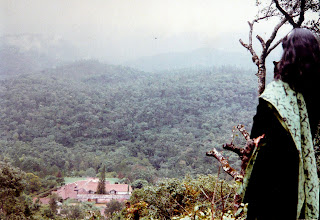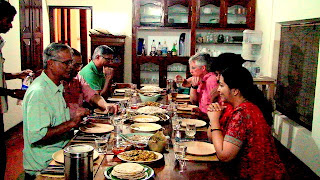The Maharajah of Cochin and the Rawalji of Badrinath

Maharajah Rama Varma of Cochin (r.1932-41)
Maharaja Rama Varma of Cochin - Chowarayil Theepetta Thampuran – was popularly known as Dharmika Chakravarthy and ruled the state from 1932 to1941. Cochin made great progress under this Maharajah who was known for his extreme simplicity and lofty commitment to the country. Sir. R.K.Shanmugham Chetty, the first Finance minister of independent India, was the Diwan- Prime minister- of Cochin during the period from 1931 to 1945, thus serving most of his tenure under this Maharajah.

Sir. Shanmugham Chetty, Diwan of Cochin (1931-45)
Much of the developments of present day Cochin were triggered during the reign of Dharmika Chakravarthy under the able initiatives of Sir. Shanmugham Chetty. The Cochin secretariat- the civil station- was established on modern administrative lines, and the high court was opened in 1938. The development of the Cochin harbour was also completed during this time. The Shanmugham road, of present day Cochin, is named after this illustrious administrator, who coined the phrase “Queen of the Arabian Sea” way back in 1931.
The innocence and simplicity of this Maharajah has found favour with many writers. VKN, the popular Malayalam humorist and Puthezhathu Raman Menon, former High Court judge, writer and Sarvadhikaryakkar (Chief Secretary) to the Maharajah have eloquently described many instances from the life of this Maharajah. I don’t want to dwell into any of these because those are outside the purview of the present note. I quote just one instance to reflect on this. The details are from the wonderfully interesting book, “Rajavamsam-Tripunithura Smaranakal” (The Dynasty- Memories of Tripunithura-) by R.T.Ravi Varma.
The maharajah used to mingle with every class of people with equanimity. He was very passionate about elephants and drums (Chenda). He was also personally familiar with all the mahouts and the owners of the elephants. Once, on a visit to the Central jail at Trichur, he recognized one of the mahouts among the convicts. “Why are you here, Rama?”, “Where is your elephant?” , he asked. Astonished at the enquiries of the Maharajah, the authorities tried to explain about the crime committed by the mahout. Discarding all their arguments, he commanded,”Either the elephant should be brought here or Raman should be set free and be sent back to the elephant.””How can a mahout live without the elephant?” Stunned at the argument, the authorities had to set free the mahout.
I attach a letter dated 10th October 1939 written to the Rawalji of Badrinath on behalf of this Maharajah by his personal secretary. Incidentally, Elamana Madhava Menon, the young personal secretary was the grandson of the Maharajah. This letter also reflects on the personality of the Maharajah in a certain way.

Letter dated 10th October 1939 from the Maharajah's PS to the Rawalji of Badrinath
This letter is addressed to P.Vasudevan Nampoothiri who was then the Rawalji of Badrinath. He hailed from Perumpalliyazhatu mana at Vaikom. This mana was a fine example of traditional Kerala architecture and the present owners had gifted this to Abhaya, a non-profit organization run by the illustrious poet and philanthropist Prof. Sugatha Kumari. They have since translocated this mana to Abhayagramam in Trivandrum retaining the original structure. (This letter reached me through my brother Vijay Varma who found it in the attic of the mana. My brother is connected to Krishnan Nambiathiri- owner of the mana- through matrimonial links in the family.)
Traditionally, the high priests of Badrinath temple are Namboothiris from Kerala. It is believed that Adi Sankaracharya had ordained this. The priest is called Rawal (Rawalji) and is periodically selected from the members belonging to a group of Brahmin families brought to Kerala from Gokarnam by the Kolathiri Rajahs. The Rawalji is to be a celibate bachelor as per tradition and he is held in very high esteem by the Hindu devotees and the Government of Uttarkhand. During the days of the British Raj too, special privileges were extended to the His Holiness the Rawalji of Badrinath by the Government of United Provinces and the royals from the princely states used to pay special obeisance to Him.
Translation of the letter in Malayalam to English
Emblem of the Government of Cochin
Hill Palace, Tripunithura,
10th October 1939
Sree
I have been ordered to convey you that the prasad, shawl etc sent from there are happily acknowledged by His Highness and that it shall further be pleasing if some musk also could be sent when available.
His Highness hopes that the telegram sent to you, asking for remitting the value of the waist-chain in gold, got done here and sent to you, is since received.
Here, His Highness and those with him are doing well. There is no further news. His Highness hopes that all of you over there are also keeping well. His Highness has further commanded for a reply in due course about all news from there.
Signed
Elamana Madathil Madhava Menon
Private Secretary to His Highness the Maharajah
To
Brahmasri. P.Vasudevan Nampoothiri Esquire,
Rawal,
Badrinath.

Temple of Badrinath
This letter is quite amusing in that the Maharajah asks the Rawalji to pay for the price of the golden waist-chain (Ponnaranjnaan). Normally, the Maharajahs used to gift away such items to eminent persons who distinguish themselves in various fields. Also, the Maharajah does not seem to have any hesitation in asking the Rawalji to send some musk (perfume obtained from the musk-deers of the Himalayas) from there when available.
These types of demi-official and personal letters throw much light into the personal preferences, likes and dislikes of the people involved and could be very interesting to read.
Fort, Tripunithura,
7th February 2011.



Comments
The letter reminded the old "Neettu" of Travancore.
Best Wishes!
kind regards,
Kindest regards,
Muralichettan
Very good post.It was very informative.I have just visited Dutch palace and museum.So i was able to know more about Rajas of Kochi.One another thing touched me most , When i came to know that 'Mana' was donated to Sugatha Kuamari's trust by its owners.It was a great gesture.Especially in this time, when people are ready to do anything for money and property.
With regards,
D C
I am very happy to note that you liked the post.Thank you.
Yes, Shinoj, there are still so many people around to whom making money is not the sole aim in life. The will for renunciation is a great aspect of Indian culture. That is why this country moves forward despite rambling corruption all around.
Kind regards,
its realy a piece of history.......
manoj
this is realy a piece of history.....
manoj
Kind regards,